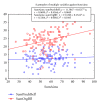The Relationship between Beliefs about Pain and Functioning with Rheumatologic Conditions
- PMID: 22792468
- PMCID: PMC3390114
- DOI: 10.1155/2012/206263
The Relationship between Beliefs about Pain and Functioning with Rheumatologic Conditions
Abstract
Pain beliefs influence understanding of pain mechanisms and outcomes. This study in rheumatologic conditions sought to determine a relationship between beliefs about pain and functioning. Participants in Arthritis New Zealand's (ANZ) exercise and education programmes were used. Demographic data and validated instruments used included the Arthritis Impact Measurement Scale 2nd version-Short Form (AIMS2-SF) to measure functioning, and two scales of organic and psychological beliefs in Pain Beliefs Questionnaires (PBQ) to measure pain beliefs. 236 Members of ANZ were surveyed anonymously with AIMS2-SF and PBQ, with a 61% response rate; 144 responses were entered into the database. This study used α of 0.05 and a 1-β of 0.8 to detect for significant effect size estimated to be r = 0.25. Analysis revealed a significant relationship between organic beliefs scale of PBQ and functioning of AIMS2-SF, with an r value of 0.32 and P value of 0.00008. No relationship was found between psychological beliefs scale of PBQ and AIMS2-SF. Organic pain beliefs are associated with poorer functioning. Psychological pain beliefs are not. Beliefs might have been modified by ANZ programmes. Clinicians should address organic pain beliefs early in consultation. Causal links between organic pain beliefs and functioning should be clarified.
Figures
Similar articles
-
Psychometric properties of a Dutch short form of the Arthritis Impact Measurement Scales 2 (Dutch-AIMS2-SF).Rheumatology (Oxford). 2003 Mar;42(3):427-34. doi: 10.1093/rheumatology/keg133. Rheumatology (Oxford). 2003. PMID: 12626792
-
Evaluation and cultural adaptation of a German version of the AIMS2-SF questionnaire (German AIMS2-SF).Rheumatology (Oxford). 2005 Sep;44(9):1190-5. doi: 10.1093/rheumatology/keh718. Epub 2005 Jun 21. Rheumatology (Oxford). 2005. PMID: 15972355
-
Translation and validation of the Persian version of the Arthritis Impact Measurement Scales 2-Short Form (AIMS2-SF) in patients with rheumatoid arthritis.Clin Rheumatol. 2009 May;28(5):521-7. doi: 10.1007/s10067-008-1078-7. Epub 2009 Jan 10. Clin Rheumatol. 2009. PMID: 19137354
-
Beliefs and personality disorders: an overview of the personality beliefs questionnaire.J Clin Psychol. 2012 Jan;68(1):88-100. doi: 10.1002/jclp.20856. Epub 2011 Nov 30. J Clin Psychol. 2012. PMID: 22131105 Review.
-
Measures of disability: Arthritis Impact Measurement Scales 2 (AIMS2), Arthritis Impact Measurement Scales 2-Short Form (AIMS2-SF), The Organization for Economic Cooperation and Development (OECD) Long-Term Disability (LTD) Questionnaire, EQ-5D, World Health Organization Disability Assessment Schedule II (WHODASII), Late-Life Function and Disability Instrument (LLFDI), and Late-Life Function and Disability Instrument-Abbreviated Version (LLFDI-Abbreviated).Arthritis Care Res (Hoboken). 2011 Nov;63 Suppl 11:S308-24. doi: 10.1002/acr.20640. Arthritis Care Res (Hoboken). 2011. PMID: 22588753 Review. No abstract available.
Cited by
-
Definitions of Chronic Low Back Pain From a Scoping Review, and Analyses of Narratives and Self-Reported Health of Adults With Low Back Pain.J Pain. 2023 Mar;24(3):403-412. doi: 10.1016/j.jpain.2022.10.012. Epub 2022 Oct 23. J Pain. 2023. PMID: 36283654 Free PMC article.
References
-
- Main CJ, Foster N, Buchbinder R. How important are back pain beliefs and expectations for satisfactory recovery from back pain? Best Practice and Research. 2010;24(2):205–217. - PubMed
-
- Courvoisier DS, Agoritsas T, Glauser J, et al. Pain as an important predictor of psychosocial health in patients with rheumatoid arthritis. Arthritis Care & Research. 2012;64(2):190–196. - PubMed
-
- Truchon M, Côté D, Fillion L, Arsenault B, Dionne C. Low-back-pain related disability: an integration of psychological risk factors into the stress process model. Pain. 2008;137(3):564–573. - PubMed
LinkOut - more resources
Full Text Sources



